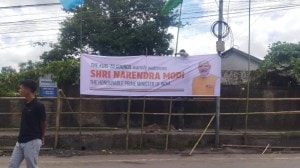China on the US strategy map
Today the US is reverting to its traditional role as an offshore balancer in Asia

The emerging wisdom among many Asia-watchers is that American power is slowly waning in Asia at a time when China is rapidly emerging as a great power. The 16-nation East Asia Summit held in Kuala Lumpur in December was noted for the conspicuous absence of the US. And, at the other end of Asia, in Astana in mid-2005, the Shanghai Cooperation Organisation called on the US to specify a timeframe to withdraw their forces from the region. It is being argued that China is fast creating a modern version of the Sino-centric regional order that was first created under the Tang dynasty (AD 618-906), by resuming its historically self-declared role as the ‘Middle Kingdom’.
So how is the US responding to China’s rise? And what role, if any, does it intend for India to play in its grand strategy for Asia? According to the noted American political scientist John Mearsheimer, the foremost goal of a great power is regional hegemony while preventing other great powers from achieving hegemony in their own regions. As the most powerful state in the system, the hegemon dominates all the ‘‘lesser’’ states in its region. The US is the only regional hegemon in modern history as it dominates the western hemisphere. Throughout the 20th century, the US preferred local great powers to contain or balance the emergence of a potential hegemon. However, when local great powers were unable to do the job, the US took appropriate steps to deal with the potential hegemon. This led analysts to see the US as an ‘‘offshore balancer’’.
Today the US is reverting to its traditional role as an offshore balancer in Asia. The US wants
local great powers, Japan and India, to prevent China’s emergence as a potential hegemon. However, given China’s size and rise, the US is not taking any chances. It is in the process of putting in place a politico-military security architecture in the Pacific to prevent China’s emergence as a regional hegemon if the Asian great powers are unable to do the job. For instance, the second Bush administration enunciated its new grand strategy towards India on March 25, 2005, when the State Department said that the US had decided ‘‘to help India become a major world power in the 21st century’’.
However, America is not putting all its eggs in the Japanese and Indian baskets. The US is in the process of setting up a politico-military security architecture centred on the US Pacific Command (PACOM) in Honolulu to deter a rising China from turning aggressive. PACOM is fast establishing defence and diplomatic ties with traditional allies like Japan, Thailand and Australia while cultivating links with new friends like India and Vietnam. As a result of its ‘war on terror’, the US has also established its military presence in Central Asia. Moreover, the US is in the process of establishing ‘cooperative security locations’ (CSLs) in East Africa and Asia. CSLs are bases that the US intends to use in the event of a crisis, without formal basing rights.
As America reverts to its traditional role as an offshore balancer in Asia, India would do well to remember that while the US has historically tried to ‘‘balance’’ or ‘‘contain’’ its peer-competitors, it has also historically tried to ‘‘engage’’ and ‘‘bind’’ its friends and allies. For example, during the Cold War, the US enmeshed the foreign and security policies of Britain, Germany, France and Japan through alliances dominated by Washington. Currently, while the US is keenly engaging India in the civil nuclear field, it is also trying to bind New Delhi’s policy towards Tehran.
Given America’s pre-eminent position in the international order and the power differential between the US and India (its economy is almost 16 times larger than the Indian economy and America’s defence budget is more than 20 times that of India), the strategic reality for New Delhi is such that a close relationship with Washington is a pre-requisite for it to realise its great-power dream. However, New Delhi can potentially circumvent the binding effects of a close relationship with Washington by increasing the options for itself. India must rapidly expand its internal resources — economic and military — while cultivating strong ties with other important powers like China, Russia, the EU and Japan, as it engages America.
The writer is an associate research fellow at the Institute of Defence and Strategic Studies, Singapore
Photos





- 01
- 02
- 03
- 04
- 05


























